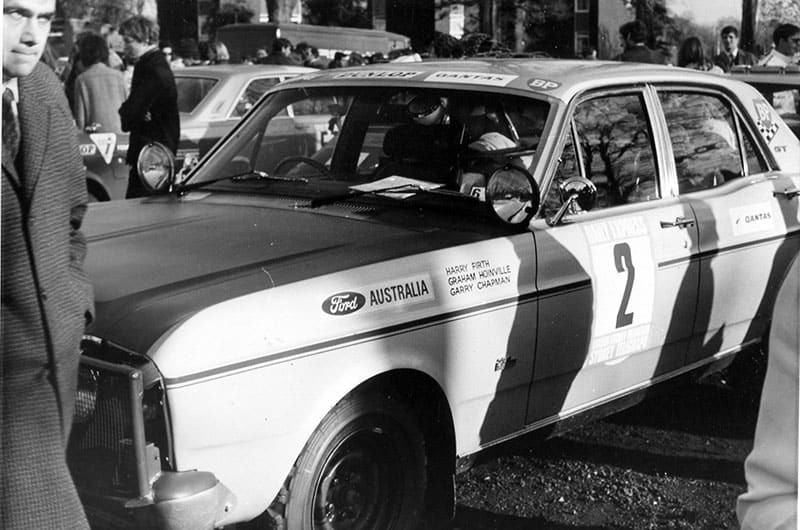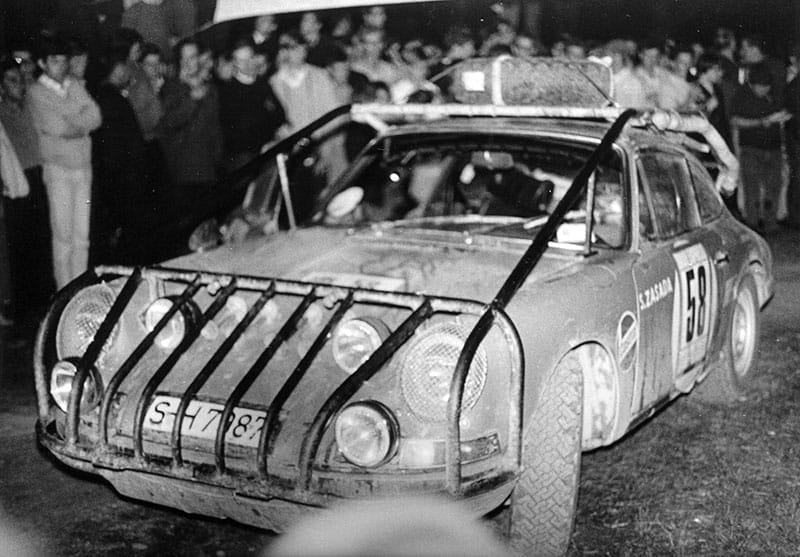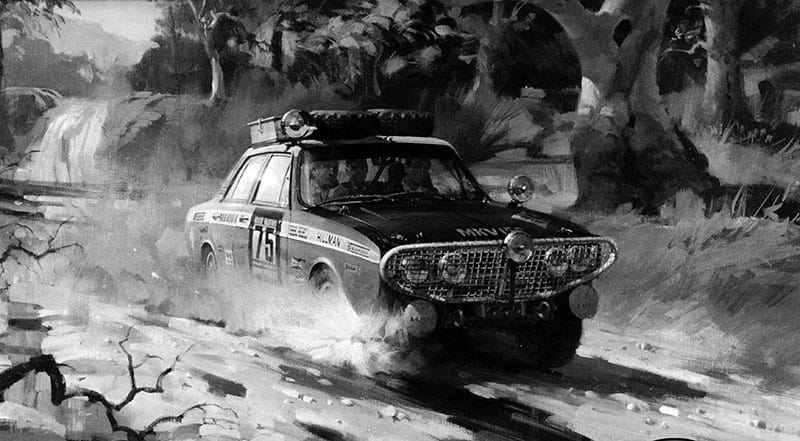* * * * *
Although some more recent marathons were longer and sometimes tougher, the original event set standards that even today are hard to beat. It was a watershed event that excited both private and works teams, not to mention the dozen or so countries through which it ran. When entries closed early in November of 1968, 98 hopefuls had entered, a figure that was predominantly made up of privateers, plus a handful of “works” teams including Ford, BMC and Rootes. It was to be a rally that attracted the world’s media and was viewed by millions of people around the world. And Australia was to be part of the route, using some of the toughest roads on the Australian continent – the Nullabor Plain, the Flinders Ranges and the Victorian alps. The London – Sydney Marathon excited millions and saw a surprise ending after high drama on the final day.
Andrew Cowan (left) accepts the congratulations of NSW premier Askin at the finish in Sydney.
BIG MONEY PRIZES
The original 1968 Marathon was the result of discussions over a long lunch in London late in 1967, during a period of despondency in Britain which was caused by the devaluation of the English currency, the pound. The proprietor of the Daily Express newspaper, Sir Max Aitken, and two of his staff, Tommy Sopwith and Jocelyn Stevens, were looking for an event which their newspaper could sponsor and which would raise the spirits of the British public and boost export sales at the same time. After much discussion, they agreed on a long distance motoring event that would pass through many different countries where British engineering and enterprise could be promoted. Aitken, on behalf of the Daily Express, offered a £10,000 winner’s prize which was soon joined by a £3000 runner’s-up award and two £2000 prizes for the third-placed team, for the highest-placed Australians, which were underwritten by the Australian Daily Telegraph newspaper. The Telegraph’s proprietor, Frank Packer, saw the value in supporting this unique event and particularly in promoting the Australian leg of the event. There had been several long distance events in the past, most notably the Peking to Paris race of 1907 which covered 9,317 miles (14,994km) from Beijing to Paris, so an event as long as the 1968 LSM caught people’s attention. There was the initial presumption that the proposed event was not to be taken too seriously. However, by the time the entire route had been disclosed, the sheer magnitude of the Marathon became obvious and it fired the imagination of not just the competitors, but also motor manufacturers who could see the value in promoting their products in a very public manner. Realising that an event of this magnitude would take a long time to plan and execute, Sopwith and Stephens got stuck into initial planning in January 1968. With the wheels quickly in motion, an eight-person organizing team was established to plan a suitably challenging and navigable route from London to Sydney.
The factory Ford Falcon of Harry Firth, Graham Hoinville and Garry Chapman. Photo: Jeff Whitten
MAJOR HURDLES
One major hurdle quickly presented itself - getting cars and crews from India to Australia, which would normally involve a long sea trip. In the end the organizers were able to arrange for the use of the P&O Lines vessel, the SS Chusan, to shift the cars and crews from one continent to another, however, the Chusan’s capacity was just 72 vehicles, a figure which was initially thought to be overly generous anyway. Considering the magnitude of the event, the organizers were in no doubt that much of the almost 100-strong field would not make it to Bombay anyway. They were proved to be wrong in the end. After reaching Fremantle after nine days at sea, cars were to be impounded for two days to give crews the opportunity to catch up on sleep and prepare their vehicles for the final 2,600 mile leg across Australia. As it transpired most competitors wanted nothing more than to get back behind the wheel and hotfoot it to Sydney as soon and as quickly as they could. Those two days of inactivity, on top of the long sea trip, were somewhat of an anti-climax and crews were champing at the bit, desperate to be on the move again.
Sobieslaw Zasada's Porsce 911 at the late night time control in Edi, Victoria. Photo: Jeff Whitten
STING IN THE TAIL
The Australian leg, from Fremantle to Sydney, was expected to produce a clear winner given Australia’s rugged outback roads, just what the organizers hoped for. Leaving Perth the route was to head north west to the tiny Western Australian locality of Youanmi, from where it turned south east, through Marvel Loch and on to Lake King in South Australia. Then it was to be east to Ceduna via the Nullabor Plain, on to Quorn, into South Australia’s infamous Flinders Ranges and the rugged Brachina Gorge, before crossing the border into Menindee in NSW. If there were any competitors left at this point they would be faced with an all-stops-out blast over some of Australia’s worst, albeit picturesque, roads and forest tracks. This consisted of a blast through the Victorian Alps in the dead of night before finally finishing at Sydney after a frantic 2,600 mile race from Perth, in just 70 hours. That drive would have been almost an impossibility today, much less 50 years ago, but the organizers wanted to ensure that the Marathon was a true test of man and machine. By the time the leading crews reached Mingary in the Flinders Ranges in South Australia, crews began to experience a variety of terminal problems. Roger Clark, driving a Ford factory-entered Lotus Cortina, and the event leader at that point, experienced a bad mis-fire in the Cortina’s engine. Ford officials decided that Clark had a better chance of a good placing than his teammate, Eric Jackson (also in a Lotus Cortina), so they removed the head from Jackson’s car and fitted it to Clark’s and sent him on his way. Of the 98 cars that started from London, 61 had made it to Mingary, many of them very much worse for wear. Soon after, in the rugged Flinders Ranges, Andrew Cowan’s Hillman Hunter became stuck in the sand and had to be towed out by “Gelignite” Jack Murray. It was an act that would help shape the final results of the Marathon.
An artist's impression of Andrew Cowan's winning Hillman Hunter in action.


